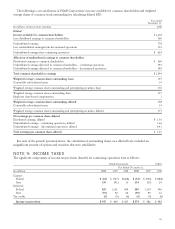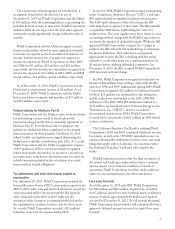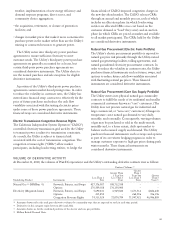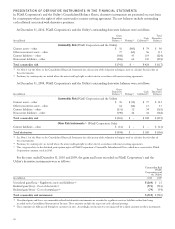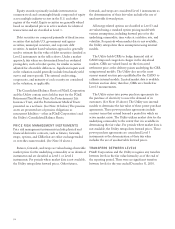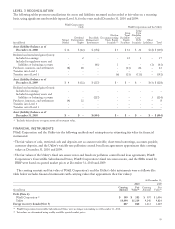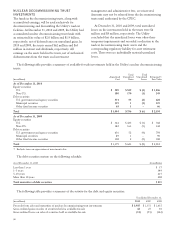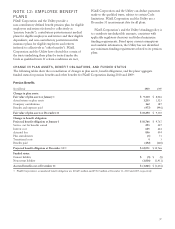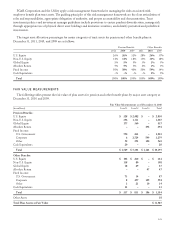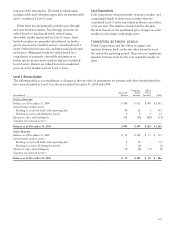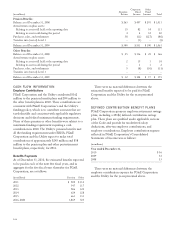PG&E 2010 Annual Report Download - page 98
Download and view the complete annual report
Please find page 98 of the 2010 PG&E annual report below. You can navigate through the pages in the report by either clicking on the pages listed below, or by using the keyword search tool below to find specific information within the annual report.Equity securities primarily include investments in
common stock and commingled funds composed of equity
across multiple industry sectors in the U.S. and other
regions of the world. Equity securities are generally valued
based on unadjusted prices in active markets for identical
transactions and are classified as Level 1.
Debt securities are composed primarily of fixed income
securities that include U.S. government and agency
securities, municipal securities, and corporate debt
securities. A market based valuation approach is generally
used to estimate the fair value of debt securities classified as
Level 2 instruments in the tables above. Under a market
approach, fair values are determined based on evaluated
pricing data, such as broker quotes, for similar securities
adjusted for observable differences. Significant inputs used
in the valuation model generally include benchmark yield
curves and issuer spreads. The external credit rating,
coupon rate, and maturity of each security are considered
in the valuation, as applicable.
The Consolidated Balance Sheets of PG&E Corporation
and the Utility contain assets held in trust for the PG&E
Retirement Plan Master Trust, the Postretirement Life
Insurance Trust, and the Postretirement Medical Trusts
presented on a net basis. (See Note 12 below.) The pension
assets are presented net of pension obligations as
noncurrent liabilities – other in PG&E Corporation’s and
the Utility’s Consolidated Balance Sheets.
PRICE RISK MANAGEMENT INSTRUMENTS
Price risk management instruments include physical and
financial derivative contracts, such as futures, forwards,
swaps, options, and CRRs that are either exchange-traded
or over-the-counter traded. (See Note 10 above.)
Futures, forwards, and swaps are valued using observable
market prices for the underlying commodity or an identical
instrument and are classified as Level 1 or Level 2
instruments. For periods where market data is not available,
the Utility extrapolates forward prices. Other futures,
forwards, and swaps are considered Level 3 instruments as
the determination of their fair value includes the use of
unobservable forward prices.
All energy-related options are classified as Level 3 and
are valued using a standard option pricing model with
various assumptions, including forward prices for the
underlying commodity, time value at a risk-free rate, and
volatility. For periods when market data is not available,
the Utility extrapolates these assumptions using internal
models.
The Utility holds CRRs to hedge financial risk of
CAISO-imposed congestion charges in the day-ahead
markets. CRRs are valued based on the forecasted
settlement price at the delivery points underlying the CRR
using internal models. The Utility also uses the most
current annual auction prices published by the CAISO to
calibrate internal models. Limited market data is available
between auction dates; therefore, CRRs are classified as
Level 3 measurements.
The Utility enters into power purchase agreements for
the purchase of electricity to meet the demand of its
customers. (See Note 10 above.) The Utility uses internal
models to determine the fair value of these power purchase
agreements. These power purchase agreements include
contract terms that extend beyond a period for which an
active market exists. The Utility utilizes market data for the
underlying commodity to the extent that it is available in
determining the fair value. For periods where market data is
not available, the Utility extrapolates forward prices. These
power purchase agreements are considered Level 3
instruments as the determination of their fair value
includes the use of unobservable forward prices.
TRANSFERS BETWEEN LEVELS
PG&E Corporation and the Utility recognize any transfers
between levels in the fair value hierarchy as of the end of
the reporting period. There were no significant transfers
between levels for the year ended December 31, 2010.
94



